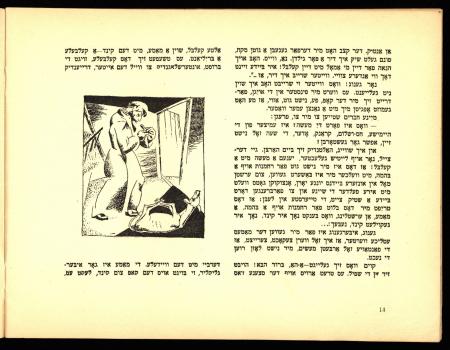Obj. ID: 38308
Jewish printed books Dos Kelbl (The Calf) by Mendele Moicher Seforim, Warsaw, 1919

This text was prepared by William Gross:
Dos Kelbl [The Calf], Mendele Mocher Sforim. Warsaw: Kultur Lige, 1922. Yiddish. Excerpts from "Sefer HaBehemot" by Mendele Mocher Sforim with small illustrations by Joseph Tchaikov. Cover and title page with an identical illustration designed by Joseph Tchaikov
CHAIKOV, Iosif Moisevich [Joseph Tchaikov] (1888-1979) (illustrator) and Peretz MARKISH. Di Kupe [The Mound]. Kiev: Kultur Liga, 1922. 36 pp., 8vo (180 x 113 mm).
Original decorated wrappers designed by I. Chaikov. Condition: wrappers lightly discolored, light pencil marks to bottom of front wrapper. one of 3000 copies.
Chaikov was a Jewish sculptor, graphic artist, teacher and art theoretician. He studied with Natan Aronson in Paris from 1910 to 1913 and at the School of Decorative Arts and the School of Liberal Arts. On his return to Russia in 1914, he became active in many Jewish artists' organizations. In 1918 he helped found the Kultur Liga Art Section in Kiev. He also frequently contributed to Yiddish books and magazines. He worked in Berlin in 1922 and 1923 and participated in sections of Soviet art in the Berlin International Exposition. In 1925 he joined the Association of Soviet Sculptors (ORS) in Moscow and another artists' association "Four Arts." He also taught sculpture in an art and technical institute. Perets (1895-1952) was an important Soviet Jewish poet, playwright and novelist who wrote in Yiddish. Although he embraced the Russian Revolution and was later awarded the Order of Lenin in 1939, he was accused of Zionism as a member of the Jewish Anti-Fascist Committee. Stalin executed him along with other Jewish writers on the Night of the Murdered Poets of August 12, 1952. Di Kupe was written in response to the Ukrainian pogroms of 1919 to 1920. MoMA 374.
Biography
Born in Kiev and initially trained as an engraver, Chaikov studied in Paris in the years 1910 through 1914. In 1912 he co-founded a group of young Jewish artists called Mahmad, and published a Hebrew-language magazine with that name; in 1913 he participated in the Salon d'Automne.
He returned to Kiev in 1914. He was co-founder, along with El Lissitzky, Boris Aronson and others, of the Jewish socialist Kultur Lige in Kiev, led sculpture classes there, supervised a children's art studio and illustrated children's books, and in post-revolutionary Kiev focused on billboards and agitational propaganda. In 1921 he published the Yiddish-language book Skulptur, advocating avant-garde sculpture as a contribution to a new Jewish art. This book was also the first book on sculpture to be published in Yiddish.[1][2]
Chaikov moved to Moscow to teach at Vkhutemas from 1923 to 1930, alongside fellow sculptors Boris Korolev and Vera Mukhina. All three designed and taught cubist sculpture in the distinctively Russian Cubo-Futurism style, radically geometric and highly dynamic. From 1929 Chaikov was the head of the Society of Russian Sculptors. In 1932, after the end of the period of artistic freedom, all of these cubists turned back to Socialist Realism and produced more classically styled work.
In the 1930s his work was prominently shown at the two Soviet world's fair pavilions, for the 1937 Paris Exposition and the 1939 New York World's Fair. His work in Paris was an extensive frieze of nine-foot figures, the People of the USSR, carved on two steles flanking the entrance to the pavilion. Fragments of the Paris work were unearthed in rural France in the 2000s, after having been presented to the French labor union after the fair, relocated to a holiday ch?teau, broken up by pro-Nazi youth during the occupation, and buried for 50 years.[3]
Chaikov continued to work in a variety of genres, techniques and scales. He was named an Honored Artist of the USSR in 1959, and his work is in the permanent collection of MOMA.
He died in Moscow.

















